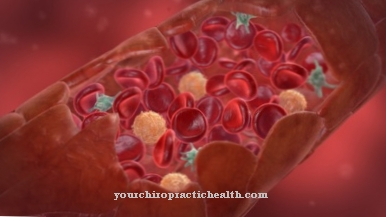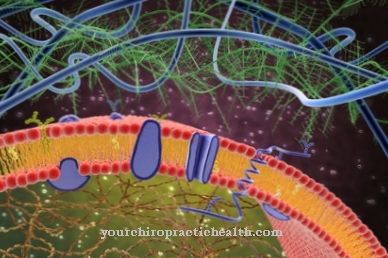Of the Breathing limit is the maximum respiratory time that can be achieved and is usually calculated on a minute basis. The norm values are an average of 120 to 170 liters, whereby mainly there are age-specific fluctuations. A strongly reduced breathing limit indicates ventilation disorders such as hypoventilation.
What is the breath limit?

Human respiration is physiologically characterized by different volumes. These volumes describe the breathing air in the lungs and the airways. The room sizes are known as breathing gas volumes, breathing volumes or lung volumes. Pneumology measures the various volumes using methods such as spirometry.
The breathing limit value is a tidal volume. This is the volume of breathable air that can be inhaled and exhaled within a certain period of time. The breathing limit is measured at maximum tidal volume and maximum breathing rate and is achieved through hyperventilation. The breathing limit thus corresponds to the respiratory time volume that a subject can maximally achieve through voluntary breathing.
One minute is usually set as the unit of time for the respiratory time volume. Under physiological conditions, the minute volume results from the respiratory rate multiplied by the tidal volume. Under stress or under the conditions of a breathing limit test, the physiological minute ventilation is multiplied. In the case of athletes, a multiplication of up to 15 times is conceivable.
Function & task
The lungs are a pair of organs that enable active breathing in the human organism. The place of gas exchange are the alveoli. Oxygen is drawn from the air we breathe and is diffused into the bloodstream, where a large part of the hemoglobin binds. Oxygen reaches all areas of the body via the bloodstream.
The types of tissue are dependent on the supply of oxygen. If the organs and tissues receive little or no oxygen over a certain period of time, they irreversibly die. In addition to the uptake of oxygen, the release of carbon monoxide also takes place in the lung alveoli. If this delivery is hindered, symptoms of poisoning occur.
The human respiratory volumes ensure that sufficient gas exchange can take place and that the organs and tissues are supplied with sufficient oxygen. For this purpose, an adult breathes an average of 12 to 15 times a minute. With every breath he takes in a tidal volume of around 500 to 700 milliliters. This results in an average minute ventilation of around eight liters. This volume corresponds to the volume at which physiological lung respiration supplies all body tissues and organs with an ideal amount of oxygen within one minute.
The breathing limit value does not result from the physiological breathing conditions, but corresponds to the maximum possible minute ventilation. The mouthpiece of a pneumotachograph is placed in the patient's mouth for measurement. He is then instructed to hyperventilate for a maximum of ten seconds. The measured value is converted to one minute.
The norm for the breathing limit is between 120 and 170 liters per minute. Depending on age and size, there may be fluctuations. If the breathing limit is severely reduced, there is probably a ventilation disorder, which can be determined more precisely using examinations such as spirometry, the Tiffeneau test or body plethysmography.
Over-the-counter medicines for respiratory diseases
Information here:
You can find your medication here
➔ Medication for shortness of breath and lung problemsIllnesses & ailments
Ventilation disturbances impair the ventilation of the lungs and thus the gas exchange in the alveoli. The disorders are either obstructive or restrictive. In addition to a pathological decrease, a ventilation disorder can just as easily be characterized by a pathological increase in lung ventilation. However, the breathing limit value usually only says something about reduced values and can therefore be used as a criterion for diagnosing hypoventilation.
Restrictive hypoventilation restricts the flexibility of the lungs or thorax (chest). Thoracic trauma are also possible causes. The same applies to neuromuscular diseases, adhesions or pulmonary edema. Often, restrictive hypoventilation also corresponds to pneumonia.
Obstructive ventilation disorders differ from restrictive ones in their cause. In addition to an increased flow resistance, there is usually an increased breathing resistance in these diseases. The airways are prone to collapse and patients have difficulty breathing out, especially when exhaling. In addition to bronchial asthma, mechanical causes such as cystic fibrosis of cystic fibrosis or chronic bronchitis can cause obstructive ventilation disorders. A lack of elastic fibers, which reduces the breathing force, is also conceivable.
With hypoventilation, pulmonary gas exchange is restricted.As a result, hypercapnia, hypoxemia and respiratory acidosis set in. The patient's CO2 exhalation is lower than the production. For this reason there is an increased partial pressure of CO2 in the blood. In addition to the diseases mentioned, a possible cause is paresis of the respiratory muscles, which is usually preceded by a lesion of the phrenic nerve. Damage to the respiratory center in the central nervous system can also cause hypoventilation.
Sometimes, instead of damage, there is only a central nervous dysregulation, for example due to the influence of drugs on the central nervous system. Hypoventilations also characterize clinical pictures such as Pickwick syndrome. In order to narrow down the cause of hypoventilation and a reduced breathing limit value, the additional examinations mentioned are necessary.



.jpg)









.jpg)

.jpg)
.jpg)










